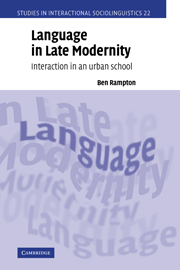Book contents
- Frontmatter
- Contents
- List of tables
- List of figures
- Acknowledgements
- Transcription conventions
- Part I Introduction
- Part II Urban classroom discourse
- 2 Talk in class at Central High
- 3 Popular culture in the classroom
- Part III Performances of Deutsch
- Part IV The stylisation of social class
- Part V Methodological reflections
- References
- Index of names
- Subject index
3 - Popular culture in the classroom
Published online by Cambridge University Press: 22 September 2009
- Frontmatter
- Contents
- List of tables
- List of figures
- Acknowledgements
- Transcription conventions
- Part I Introduction
- Part II Urban classroom discourse
- 2 Talk in class at Central High
- 3 Popular culture in the classroom
- Part III Performances of Deutsch
- Part IV The stylisation of social class
- Part V Methodological reflections
- References
- Index of names
- Subject index
Summary
In the last chapter, I concentrated on an educational genre, whole-class discussion fronted by the teacher, and I outlined a number of modifications to its canonical form evidenced in Class 9A. Teacher-fronted discussion was now open to quite a wide variety of different expressive practices, and in this chapter, I focus on some of the practices associated with popular media culture. The centre of attention shifts, in other words, from a genre associated with learning and work to practices associated with consumption and leisure, and the guiding question is: How far, and in what ways, was classroom activity influenced by popular media culture in general, and by popular music in particular?
I won't be able to engage directly with the question of historical change in this chapter, since I haven't accessed any loosely comparable datasets or reports on popular cultural practices in class from the 1960s–80s (compare Chapter 2.7). But instead of trying to achieve time depth empirically, I shall try to work quite systematically through some of the very different kinds of process that are necessarily involved when, for example, it is claimed that changes in popular media culture are altering the way kids listen to their teachers.
- Type
- Chapter
- Information
- Language in Late ModernityInteraction in an Urban School, pp. 94 - 134Publisher: Cambridge University PressPrint publication year: 2006



